| Pages:
1
..
5
6
7
8
9
..
33 |
Hennig Brand
International Hazard
    
Posts: 1284
Registered: 7-6-2009
Member Is Offline
Mood: No Mood
|
|
2g of Picric Acid Initiated in 7.6mm id Al Tubing by 0.40g of Hand Pressed DDNP Using Steel Reinforcing Cap
Another test was performed. Everything was done the same as the last test except that 0.40g of DDNP was used. All materials used were identical to the
last test. As you can see from the pictures going from 0.50g to 0.40g of DDNP has resulted in severely diminished output from the 2g picric acid base
charge even though it was completely detonated. The hole in the witness plate, for this test, looks very close to the holes produced in the tests
where 1.5g of picric acid and more DDNP was used.
I am still not happy with how well the reinforcing cap is locked into place. I like Rosco's idea of cutting a few threads in the upper section of the
wooden locking bushing and putting some adhesive in those threads before pressing the bushing into place. This method would result in a much more
secure reinforcing cap.
In this configuration 0.40g of DDNP will detonate my picric acid (purity over 98% by melting point), but is not driving it hard enough resulting in
diminished base charge output.
I have included a few pictures of the test. The hole on the right, in the witness plate shots, is from this test.
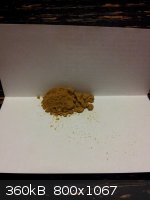 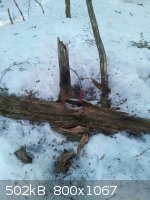 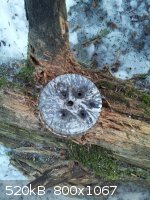
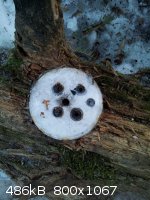 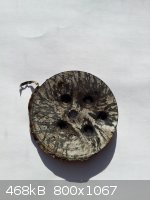 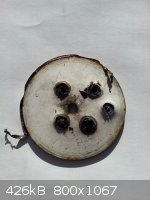
[Edited on 9-3-2014 by Hennig Brand]
"A risk-free world is a very dull world, one from which we are apt to learn little of consequence." -Geerat Vermeij
|
|
|
Rosco Bodine
Banned
Posts: 6370
Registered: 29-9-2004
Member Is Offline
Mood: analytical
|
|
Explosives by Marshall 1915
Attached is a file of interest which describes some of the aspects of basic principles that are involved with explosives and are readily observed on
the smaller scale with primary explosives used as initiators. This morning I had typed a comprehensive post on the subject but it disappeared when I
attempted to submit the message, evidently a forum software glitch that also logged me out. I will attempt later to recompose my earlier attempted
reply.
Attachment: Pages from Explosives by Arthur Marshall 1915.pdf (595kB)
This file has been downloaded 842 times
|
|
|
Rosco Bodine
Banned
Posts: 6370
Registered: 29-9-2004
Member Is Offline
Mood: analytical
|
|
Sensitiveness to Detonation of TNT and Tetryl
Attached is a very interesting article, which contains information explaining the reputation of tetryl for being the ideal base charge for a compound
detonator. Tetryl would probably function well also as an intermediate component in a firing train.
Sensitiveness to Detonation of TNT and Tetryl by Taylor and Cope
attached
Attachment: Sensitiveness to detonation of trinitrotoluene and tetranitromethylanilin - Taylor and Cope.pdf (583kB)
This file has been downloaded 1070 times
[Edited on 10-3-2014 by Rosco Bodine]
|
|
|
Hennig Brand
International Hazard
    
Posts: 1284
Registered: 7-6-2009
Member Is Offline
Mood: No Mood
|
|
Those are some great pieces of reading. I have skimmed through, but will read them through more carefully when I have more time. As an explosive
tetryl sounds great, but it is apparently very carcinogenic. I notice that it is often stated, in the old literature, that it doesn't take much, or
sometimes any, more mercury fulminate to initiate TNT than it takes to initiate picric acid. I also notice that except for the storage stability
problems, at higher temperature and/or elevated humidity, mercury fulminate can be a fairly effective initiator. Like DDNP, mercury fulminate does
require confinement, however, and according to the Matyas text crystal size is also quite important in the case of mercury fulminate.
[Edited on 10-3-2014 by Hennig Brand]
"A risk-free world is a very dull world, one from which we are apt to learn little of consequence." -Geerat Vermeij
|
|
|
Rosco Bodine
Banned
Posts: 6370
Registered: 29-9-2004
Member Is Offline
Mood: analytical
|
|
What is interesting to me is there is a chemical aspect to initiation which will cause a particular initiator to work especially well in combination
with a particular secondary, and that chemical match can even over rule what may be expected based purely upon the brisance or strength of the
initiator.
For example with lead azide it takes about 20% less to initiate styphnic acid than picric acid as would be expected based upon lead azide being the
constant and the base charge sensitivity relationship. But that is reverse to what is reported when silver azide is used because for some reason
styphnic acid is not more sensitive to initiation by silver azide than is pcric acid. Thus the chemical component or some unidentified aspect causes
the result to be opposite what would be expected from experience with use of lead azide.
And for tetryl it is reported that even as little as 1 mg lead azide will initiate tetryl sometimes and 10 mg is certain to initiate tetryl. This
shows an extraordinary example of how a particular initiator is excellent for use with a particular secondary because of some chemical and / or
physical matchup.
It makes me wonder if there is a "special case" matchup for a particular pairing of less quickly accellerating initiators like DDNP, is there some
particular choice of base charge which pairs best with DDNP so that a lower minimum amount of DDNP is required, or is the peculiarity of sensitivity
of tetryl and lead azide something that only occurs for the more instantaneous initiators like lead azide.
|
|
|
Hennig Brand
International Hazard
    
Posts: 1284
Registered: 7-6-2009
Member Is Offline
Mood: No Mood
|
|
It is interesting how the effectiveness of a particular primary can vary greatly relative to others depending on which secondary is being initiated.
DDNP is reported, in "Military Explosives" and several other references I have seen, as being very well matched to picric acid and TNT among others.
The text "Military Explosives" states that it is superior to lead azide for initiating picric acid and TNT, IIRC. I bet if some threads were put on
the locking bushing, and some epoxy was smeared on those threads before pressing the bushing into place, we would see even greater picric acid
initiating ability from the DDNP.
"A risk-free world is a very dull world, one from which we are apt to learn little of consequence." -Geerat Vermeij
|
|
|
Rosco Bodine
Banned
Posts: 6370
Registered: 29-9-2004
Member Is Offline
Mood: analytical
|
|
I suspect there is a binary mixture or a coprecipitate of DDNP which will improve its accelleration considerably and allow its strength to make a
better showing, that it can be accellerated in a synergistic mixture similarly as can other initiators which have strength but are deficient in self
accelleration rapidity such as is lead styphnate for one example. The classic example is tetracene mixed with nitromannite, where tetracene is a
weak initiator and nitromannite is not strictly an initiator at all, but the mixture of the two is reportedly a powerful initiator. I believe there
are many potential synergistic mixtures possible which are an unexplored potential for experimentation. Some of these mixtures could be "green"
friendly technology so it is likely that experiments will be conducted to attempt to identify likely candidate mixtures. Similarly it could happen
that the styphnic acid analogue of DDNP or one of its salts might be worth experimentation in combination with DDNP.
One of the materials which might be interesting as part of a binary mixture is N-Nitro-N-methylhydroxyacetamide Nitrate
http://www.sciencemadness.org/talk/viewthread.php?tid=18243&...
[Edited on 11-3-2014 by Rosco Bodine]
|
|
|
Rosco Bodine
Banned
Posts: 6370
Registered: 29-9-2004
Member Is Offline
Mood: analytical
|
|
I don't know what is the compatibility issue which may be there or how significant it may be. There is reportedly a measurable long term storage
degradation issue also for mixtures of lead azide and lead styphnate but the mixtures are used anyway because the performance gain exceeds the loss
for whatever the perfectionist may find would be most desirable in terms of perfect long term storage compatibility. For example suppose there is a
10% reduction in the average shelf life at 90+% humidity and 40C storage conditions for 20 years for the "imperfect" mixture, but the cost performance
is increased 40% and actual initiating strength output increased by 25% by using the mixture that is less than perfect. The bean counters can sort
out the better bargain based upon the practical aspects of their "climate change" modeling based on who is paying for the perfection and how much they
have to spend. It becomes a beauty is in the eye of the beholder scenario where economic practicality is governing for the free enterprise product
that will be mass produced. If lead azide and lead styphnate mixtures are in practical use for example, as they are, then silver azide substituted
for lead azide should probably work equally well IMO and likewise should work with DDNP. DDNP can actually be melt cast as a binary melt with picric
acid, so the DDNP is fairly chemically stable. The limiting factor there for a mixture of DDNP with an azide would likely then be the particular azide
chosen, and silver azide is much more chemically stable than lead azide. So then silver azide would be the more promising candidate IMO for a mixture
with DDNP.
|
|
|
Hennig Brand
International Hazard
    
Posts: 1284
Registered: 7-6-2009
Member Is Offline
Mood: No Mood
|
|
Thanks for the answer. I guess you must have seen my question from my last post before I deleted the post. I deleted it because I thought maybe we had
already covered that ground, but you did in fact know more than what was mentioned earlier in the thread. I am going over ways that a small charge of
lead azide could be isolated from the DDNP in the cap casing but still give the DDNP the quick snap it needs to get up to high velocity more quickly.
I have a couple of ideas and if I get time in the next little while results will be posted.
For me, a lot of the appeal of the DDNP & picric acid blasting cap is that DDNP is made from picric acid. The raw materials are readily available
and both explosives are relatively insensitive when compared to other explosives in their respective groups (primary & secondary explosives). If I
was to start adding azide to these caps I just might not feel the same about them. 
I have a feeling a little extra confinement might allow dropping the DDNP initiator weight per cap even more. It is next on my list of things to test.
"A risk-free world is a very dull world, one from which we are apt to learn little of consequence." -Geerat Vermeij
|
|
|
Rosco Bodine
Banned
Posts: 6370
Registered: 29-9-2004
Member Is Offline
Mood: analytical
|
|
Silver Azide has been tested in mixture with DDNP and no decomposition issue was noted and that potential issue is definitely something that the tests
would have been monitoring. So here is a pretty good indication that silver azide is compatible with DDNP. And there is an old patent GB333534 that
describes lead azide mixtures with DDNP and there is no note of any compatibility issue there either. What may be the result of long term storage
studies for adverse conditions of high humidity and temperature is another matter, but for the first impression based on the limited information it
would appear the mixtures are compatible. Silver azide is intriguing because of its chemical and thermal stability, and because its low solubility
makes possible simplified synthesis which has been however inadequately described in the English language literature.
It has been my thought that silver azide first obtained as the colloidal form gotten directly from the simplified method like the Hodgkinson patents
or the method of Angeli which have been further refined by the Russians, but for which we do not have a translation yet, could be filtered out and
redissolved in warm ammonia solution, and slowly precipitated to the high density form using the patent methods of Costain or the British ordnance
variations, or the Australian method described in the attached article.
Simplifying azide synthesis using aqueous reaction systems and hydrazine sulfate as a starting material has been one of my quests for a long time. But
my time for experiments has never been available to really pursue this interest as I would prefer.
The styphnic acid gel formation that occurs as an intermediate in some synthetic methods for lead styphnate would seem like an opportune point for
incorporation of silver azide as an added solid phase of the colloidal form or slightly larger particle form of some size found optimal, with
continuation of the lead styphnate synthesis in hopes that the lead styphnate crystals which form rapidly from the collapsing gel would nucleate and
precipitate as a physically inseparable initimate mixture which is believed would have the same synergistic effect as occurs with mixtures of lead
azide with lead styphnate. But the silver azide analogue would be expected to be more powerful and have greater storage stability. The lack of stab
sensitivity issue for neat silver azide would likely be resolved also by the mixture.
And it is possible there could be a ternary mixture with DDNP gotten by suspension of particles of the silver azide / lead styphnate composite in a
warm acetone solution of DDNP,
with slow precipitation of the DDNP as an encapsulation of the particles to produce something like a ball powder form of DDNP having an interesting
core material for every little sphere.
Attachment: GB333534 DDNP lead azide mixture .pdf (130kB)
This file has been downloaded 782 times
Attachment: Sensitization of High Density Silver Azide to Stab Inititiation ADA132994.pdf (1MB)
This file has been downloaded 1014 times
Attachment: Azide Pages from Thorpe A_dictionary_of_applied_chemistry.pdf (327kB)
This file has been downloaded 996 times
|
|
|
Hennig Brand
International Hazard
    
Posts: 1284
Registered: 7-6-2009
Member Is Offline
Mood: No Mood
|
|
That patent sure seems to indicate that there would be no problem mixing DDNP and lead azide. It also states that DDNP is resistant to moisture,
meaning that it can still be easily lit and function properly even under high atmospheric humidity conditions. Resistance to moisture is another
virtue for the list.
From the text “Primary Explosives” by Matyas,
“A technologically interesting way of preparing silver azide is based on mixing a solution of sodium azide with some explosive (MF, tetryl, TNT,
picric acid, etc.) before adding silver nitrate. Silver azide then forms a thin film on the surface of the added substance.
The initiating efficiency of the mixture of MF with approximately 3-5% of SA is several times higher than for pure MF and practically the same as for
pure SA.”
I am really enjoying that book.
Even just putting 0.05 or 0.1g of silver azide on top of the DDNP charge in the cap should get the DDNP up to high velocity quickly I would imagine.
The contact between the two would only be at the boundary then, though it sounds like they are quite compatible anyway. It would also be a simpler
process to just press a little SA on top of the DDNP as the cap was being loaded.
I used up all my silver azide, to initiate dynamite for blasting rocks this past summer, so I will need to make more. I was under the false impression
that it was much less stable than lead azide. A false assumption made while observing how extremely sensitive to light it is.
[Edited on 12-3-2014 by Hennig Brand]
"A risk-free world is a very dull world, one from which we are apt to learn little of consequence." -Geerat Vermeij
|
|
|
Rosco Bodine
Banned
Posts: 6370
Registered: 29-9-2004
Member Is Offline
Mood: analytical
|
|
Interesting how the data for tetryl charted in the Matayas book and imported from Grant and Tiffany is at considerable variance, like an order of
magnitude with the Taylor and Cope reported data. It becomes confusing when it becomes clear that the data is conflicting, or the measurement
criteria is different for what exactly is "minimum". It may depend on what your definition of "is" is.
[Edited on 13-3-2014 by Rosco Bodine]
|
|
|
Hennig Brand
International Hazard
    
Posts: 1284
Registered: 7-6-2009
Member Is Offline
Mood: No Mood
|
|
Without knowing exact details of how the tests were performed it is very hard to make meaningful comparisons, this is true. An experimenter really
does have to do their own testing a lot of the time.
"A risk-free world is a very dull world, one from which we are apt to learn little of consequence." -Geerat Vermeij
|
|
|
Rosco Bodine
Banned
Posts: 6370
Registered: 29-9-2004
Member Is Offline
Mood: analytical
|
|
Maybe for government financed research getting data correct within one or two orders of magnitude is close enough for government work.
|
|
|
Hennig Brand
International Hazard
    
Posts: 1284
Registered: 7-6-2009
Member Is Offline
Mood: No Mood
|
|
2g of Picric Acid Initiated in 7.6mm id Al Tubing by 0.40g of Hand Pressed DDNP Using Steel Reinforcing Cap
This cap was loaded with the same materials as was used for the last test. The only difference between this test and the last was that a slightly
longer casing was used to accommodate a slightly longer wooden bushing and that bushing had annular adhesive grooves ground into its upper section. I
forgot to take a picture of the bushing but have included a software sketch of an idealized representation. The bushing was 5/16" in diameter and
there were 5 or 6 annular rings which were about 0.5-1mm deep, about 1mm wide and spaced about 1 mm apart. A 1/8" hole was drilled through from end to
end, as before, to accept the core burning fuse.
Five minute epoxy was used as the adhesive. It was smeared on the bushing in and over the grooves and then the bushing was pressed in on top of the
steel reinforcing cap. The epoxy was only given 1 hour at room temperature to cure which is not enough time to reach full strength (16 hours for full
strength stated on several data sheets). I believe most of the strength was obtained from the 1 hour curing time however.
The test was a success. The 0.40g of DDNP detonated the 2g of picric acid and produced results very similar to the other tests were more DDNP was
used. The hole was well formed and of the same diameter as the other successful tests.
The scab on the bottom side of the witness plate was smaller and the hole was the most well formed of all the tests. I believe this was because I
accidently pressed the bottom gram or so of picric acid a bit harder than usual which would have resulted in higher velocity and higher pressure from
the detonation.
I wonder if I could get the same kind of results using only 0.30g of DDNP if enough confinement was used.
The hole on the right, in the witness plate shots, is from this test.
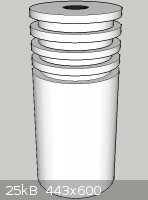 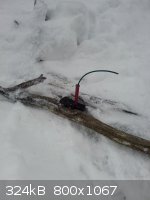 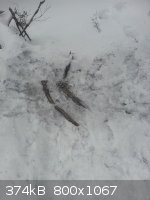
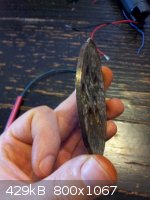 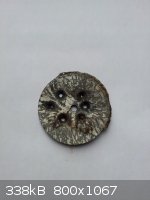 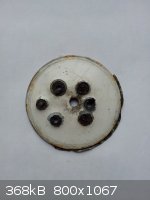
[Edited on 13-3-2014 by Hennig Brand]
"A risk-free world is a very dull world, one from which we are apt to learn little of consequence." -Geerat Vermeij
|
|
|
dave321
Harmless

Posts: 45
Registered: 22-11-2012
Member Is Offline
Mood: No Mood
|
|
what this thread needs now, is a summarised process to say produce 2g ddnp
specifying amounts, and alternative amounts of other reducers for example
along with conditions.
tech sod.sulphide vs diy sod hydroxide/ sulphur
it really would be useful instead of reading 7 pages of different processes etc
users who have succeeded in the prep could help others out a lot with this approach
.....a definitive prep that works.
|
|
|
roXefeller
Hazard to Others
  
Posts: 463
Registered: 9-9-2013
Location: 13 Colonies
Member Is Offline
Mood: 220 221 whatever it takes
|
|
But that would be spoonfeeding, and besides, plenty more is learned from reading his process.
To tell the truth, I didn't believe that the bushing was to blame for the low efficiency before. But you seem to have proven your hypothesis. Do you
think that picric acid is as good a booster as any as far as having power to kick off the next material? Yeah it doesn't have the sensitivity of
tetryl. But it has about the same power as TNT.
|
|
|
Hennig Brand
International Hazard
    
Posts: 1284
Registered: 7-6-2009
Member Is Offline
Mood: No Mood
|
|
Quote: Originally posted by dave321  | what this thread needs now, is a summarised process to say produce 2g ddnp
specifying amounts, and alternative amounts of other reducers for example
along with conditions.
tech sod.sulphide vs diy sod hydroxide/ sulphur
it really would be useful instead of reading 7 pages of different processes etc
users who have succeeded in the prep could help others out a lot with this approach
.....a definitive prep that works. |
I don't think I will be doing that. I take quite a bit of care to make sure that what I write is easily digestible. Most of the hard work is done for
you; all you need to do is read a few pages of posts. If you are unwilling to spend a little time reading about the material you intend to experiment
with, then you really have no business messing with it IMHO.
The method for DDNP from picramic acid taken from COPAE is very simple, works well and the text is free to download from this forum's library. As for
picramic acid, the process is well described and even has pictures in the picramic acid from picric thread.
BTW, my processes are not optimized. On average I am only getting about 0.5g of purified DDNP from a gram of picric acid. I would imagine that there
is room for a lot of improvement.
@ roXefeller
Picric acid is not nearly as powerful an explosive as, for instance, PETN or RDX, but from what I have read it is a very good initiator of other
explosives. There are a lot of factors which make one explosive a good initiator of another, and picric acid apparently is a fairly efficient
initiator of many secondaries.
The big thing with DDNP is confinement, but in my case purity was also an issue. When I recrystallized the crude DDNP from acetone the losses were
significant. The last time, from 2.5g of crude DDNP, only 1.8g of recrystallized DDNP was obtained which is typical of my material. BTW, I also
started using acetone at or near the boiling point to dissolve the crude DDNP, which cuts the amount of acetone needed in half or less (I haven’t
bothered to determine the exact solubility yet).
[Edited on 15-3-2014 by Hennig Brand]
"A risk-free world is a very dull world, one from which we are apt to learn little of consequence." -Geerat Vermeij
|
|
|
Hennig Brand
International Hazard
    
Posts: 1284
Registered: 7-6-2009
Member Is Offline
Mood: No Mood
|
|
Wanted to clarify something just to keep the reporting as honest as possible. Once all the burrs and paint have been removed from the witness plate it
is now measuring about 2.6mm in thickness not 3mm. I should have been a little more careful measuring it earlier. As far as I am concerned this
doesn't change the results much if at all, since the tests were more about comparisons and not how much thickness of steel was perforated. The
composition and strength of steel can also vary greatly and I have no information regarding the composition of the steel in the witness plate.
"A risk-free world is a very dull world, one from which we are apt to learn little of consequence." -Geerat Vermeij
|
|
|
roXefeller
Hazard to Others
  
Posts: 463
Registered: 9-9-2013
Location: 13 Colonies
Member Is Offline
Mood: 220 221 whatever it takes
|
|
Have you given any thought to compressing basic lead picrate into the confinement cap and then using a smaller amount of DDNP to follow it (within the
confinement cap still)? As my mind thinks about this, I'm curious if it the BLP could wake up over-pressed DDNP.
|
|
|
Hennig Brand
International Hazard
    
Posts: 1284
Registered: 7-6-2009
Member Is Offline
Mood: No Mood
|
|
Basic lead picrate is a much weaker primary than DDNP. It has a long run up distance to high order detonation and using practical quantities tends to
detonate low order. It might be interesting to see what half a gram, or a gram, could do if confined well with a reinforcing cap. I haven't tried it
so I can't say for sure, but DDNP is definitely a much more powerful primary.
Some of my earlier tests, in this thread, involved using BLP as a flash igniter to initiate the DDNP. I didn’t test it thoroughly, but it didn’t
seem to make much difference whether I used the BLP or not. DDNP accelerates to high order faster than BLP, from reading and my own observation, and
it is so easy to light on its own that it doesn’t need a flash igniter. The picrates really aren't very effective initiators in general, but the
lead salts (especially BLP) make very good flash igniters.
Regarding DDNP purity, I mentioned above that I thought purity was an issue with the DDNP I made. The reason I gave was that there were large losses
during recrystallization. At this point I wonder how much of that loss was because of sloppy recrystallization technique. Next time I will be a lot
more careful with the amount of acetone used to dissolve the crude DDNP. After all, the crystals formed from evaporative recrystallization earlier in
this thread, with no prior purification step, looked fairly clean and well formed under the microscope.
I am out of reinforcing caps and aluminum detonator casing material right at the moment or I would be trying to initiate picric acid, in the above
configuration, using only 0.30g of DDNP. It will likely be a month or so until I will have the time and be close enough to a lathe to do more testing.
The reinforcing caps can be made with only a hand drill with a little more difficulty, but I am still out of range of more aluminum tubing at the
moment. I made an aluminum reinforcing cap, from aluminum round stock, with just a hand drill and a hack saw a couple of days ago and it wasn't that
difficult. It isn't as convenient, or as easy to produce consistent results, as when using a lathe however.
[Edited on 18-3-2014 by Hennig Brand]
"A risk-free world is a very dull world, one from which we are apt to learn little of consequence." -Geerat Vermeij
|
|
|
Hennig Brand
International Hazard
    
Posts: 1284
Registered: 7-6-2009
Member Is Offline
Mood: No Mood
|
|
Free Flowing DDNP from Sodium Picramate
The first time I tried making DDNP directly from sodium picramate I used basically the same method as the one in COPAE, which was for picramic acid to
DDNP. The only difference was that a small excess of HCl was added, since it was felt that a stoichiometric amount should be added to convert the
sodium salt. The result was a much reduced yield than when picramic acid was used. At the time, it was very obvious that the reaction proceeded much
more slowly than when picramic acid was used. When picramic acid was used, the color change from a reddish brown color to DDNP brown was almost
immediate once the sodium nitrite solution was added. However, when sodium picramate was used it took several minutes and then the brown color slowly
developed.
Using the attached paper titled, "DDNP, A Detonating Explosive" as a guide I increased the reaction time a lot, as well as a couple of other small
changes.
Experimental
5g Sodium Picramate
72 mL 5.5% HCl
1.9g NaNO2 in 30 mL H2O
The 5g of sodium picramate was suspended in the 72 mL of 5.5% HCl and stirred vigorously with magnetic stirring for 10-15 minutes in an ice bath (long
enough to lower the temperature of the mixture to about 10-150C. Stirring and cooling was maintained and the 1.9g of NaNO2 in 30
mL of water was added all at once. The temperature rose slightly, when the sodium nitrite was added, but never went above 200C and dropped
to about 50C by the end of the reaction. The stirring was continued and the reaction allowed to proceed for 1 hour at which point stirring
was stopped and the DDNP was filtered out using gravity filtration. Filtering was easier, compared to the method starting with picramic acid, since
the particles were larger and didn't plug the filter as badly or hold liquid as much. The DDNP was washed, in the filter, with small quantities of ice
cold water. Yield was quantitative.
The material obtained by this method is much more dense and free flowing than the material made more directly from picramic acid using the COPAE
method. The picture shows the material as being in small clumps, however, very light pressure from the back of a spoon or even folding the filter
paper causes it to break up into dense free flowing powder.
Although this method leaves out what could be a valuable purification step, going from sodium picramate to picramic acid, it results in a much more
dense free flowing material and is much less labour intensive as well (less steps). The much slower reaction rate greatly improves the density and
handling properties of the produced material.
Attachment: DDNP a Detonating Explosive.pdf (997kB)
This file has been downloaded 916 times
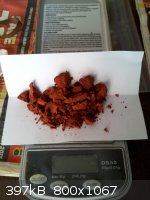 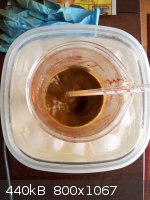 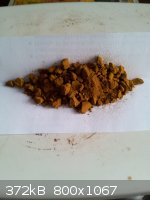
[Edited on 23-3-2014 by Hennig Brand]
"A risk-free world is a very dull world, one from which we are apt to learn little of consequence." -Geerat Vermeij
|
|
|
Hennig Brand
International Hazard
    
Posts: 1284
Registered: 7-6-2009
Member Is Offline
Mood: No Mood
|
|
2g of Picric Acid Initiated in 7.6mm id Al Tubing by 0.30g of Hand Pressed DDNP in Steel Reinforcing Cap
The test was performed with the same materials and in the same way as the last test. The picric acid was not driven hard enough by the 0.30g of DDNP
even with very strong confinement. Picric acid needs to be given a really hard kick to produce full output power. There was every indication of a
complete detonation, complete with cloud of black smoke, but the damage to the steel plate was much less than when the picric acid was overdriven
properly. There was no clean hole blown through the steel witness plate, but there was a big dent on the top side and a scab blown off the bottom side
as well as cracks which went all the way through the plate. The dent/scab on the right in the witness plate photos is from this test.
The next test will probably involve a little lead azide or silver azide to get the DDNP off to a good start.
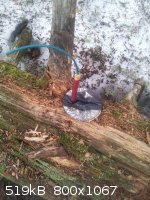 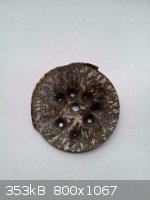 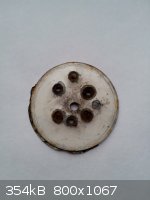
[Edited on 22-4-2014 by Hennig Brand]
"A risk-free world is a very dull world, one from which we are apt to learn little of consequence." -Geerat Vermeij
|
|
|
Jimbo Jones
Hazard to Others
  
Posts: 102
Registered: 15-10-2009
Member Is Offline
Mood: No Mood
|
|
Fascinating stuff Brand. Thanks for the hard work and the effort to put all this data and tests in the forum.
Have you ever test or planning to test the friction and impact sensitivity between DDNP and lead azide?
|
|
|
Hennig Brand
International Hazard
    
Posts: 1284
Registered: 7-6-2009
Member Is Offline
Mood: No Mood
|
|
Thank you. So far I haven't done much for friction and impact testing, but I can tell you it takes a harder blow to set off DDNP than the other
primaries I have tested such as lead azide, silver azide, lead styphnate, mercury fulminate, TATP, HMTD, etc. I haven't used a proper testing
apparatus to accurately quantify the difference, but I can say that even with a crude hammer test it is obvious that DDNP is significantly less
sensitive to impact than most other primaries commonly used. Crude tests with hammer on concrete indicate that it is relatively insensitive to
friction as well.
"A risk-free world is a very dull world, one from which we are apt to learn little of consequence." -Geerat Vermeij
|
|
|
| Pages:
1
..
5
6
7
8
9
..
33 |